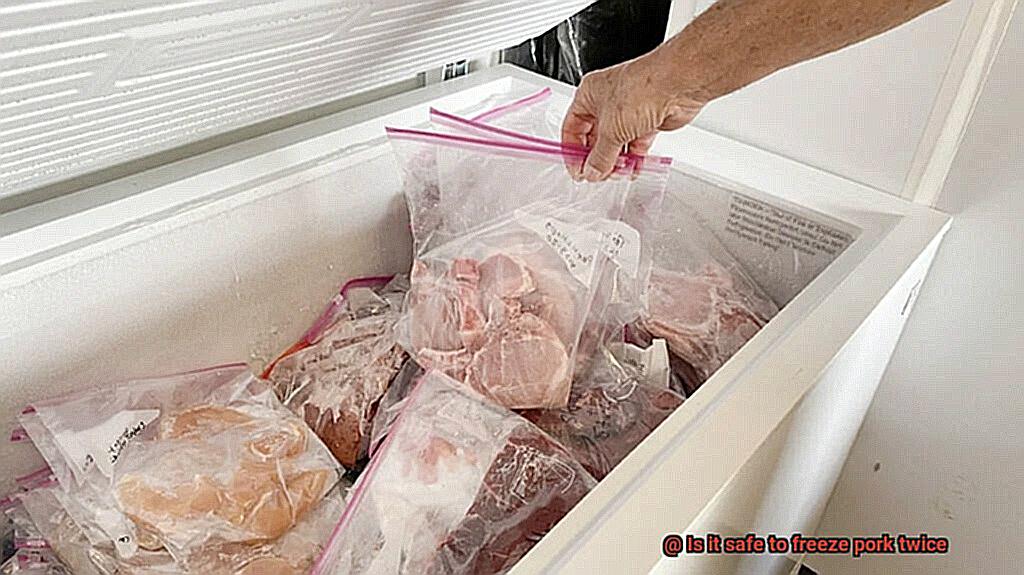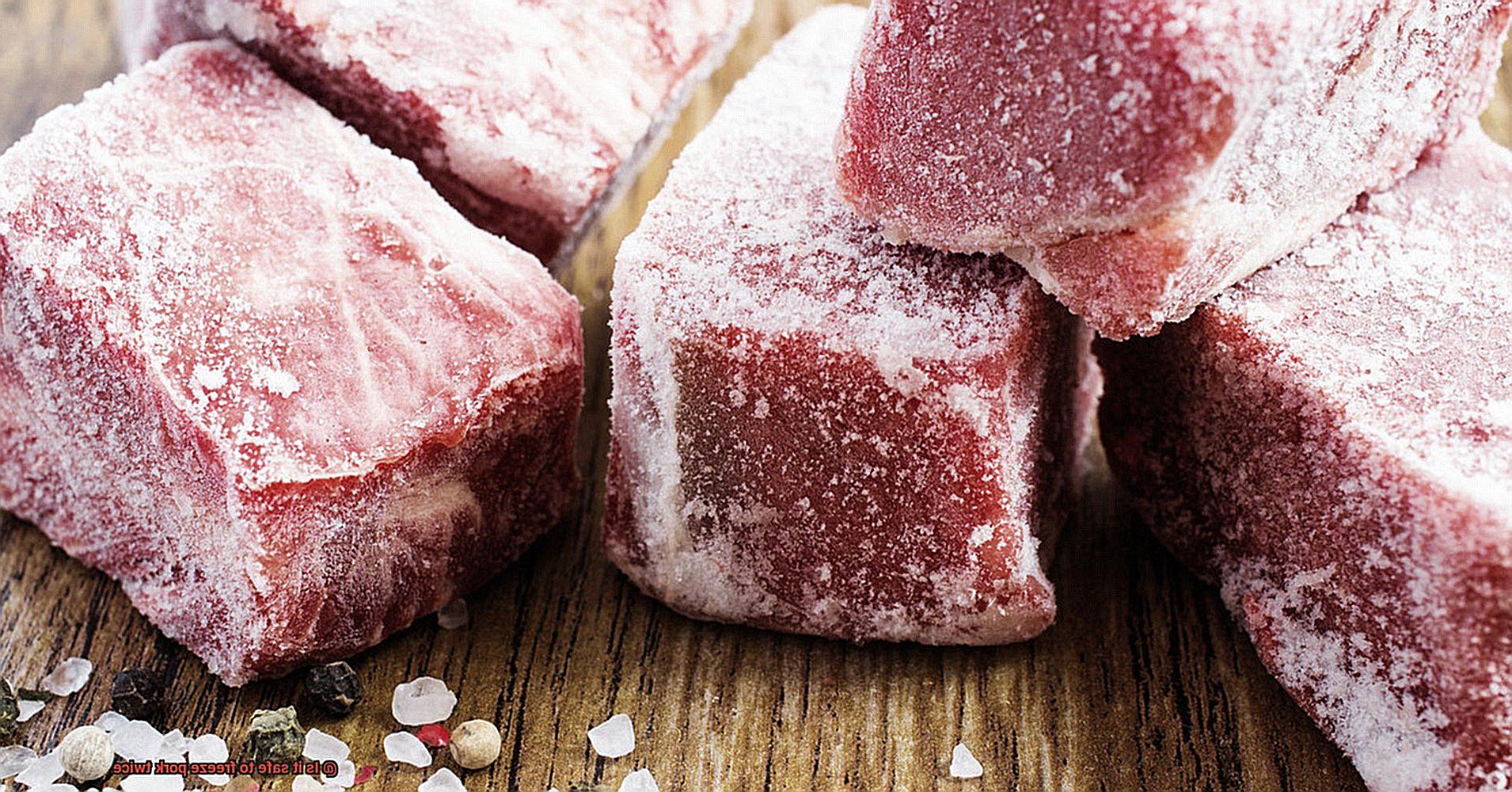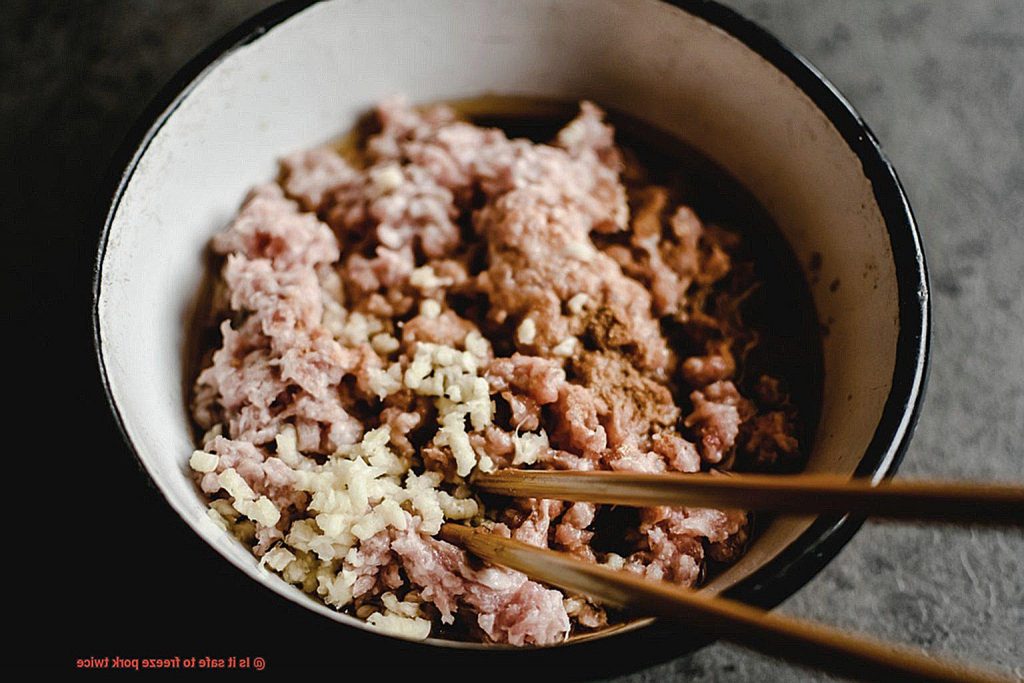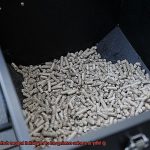Do you hate wasting half-used pork cuts because you’re unsure if it’s safe to freeze again? The question on everyone’s mind is, “Is it safe to freeze pork twice?” This inquiry is crucial as it directly impacts the safety, quality, and taste of your food. While you might assume that double-freezing pork is harmless, the answer isn’t so simple.
The thought of consuming improperly stored food can be nerve-wracking. With pork, it’s vital to understand the risks associated with double-freezing. These risks include microbial growth, loss of texture and flavor, and a higher likelihood of freezer burn. Therefore, it’s crucial to know how to store pork correctly and whether freezing pork twice is a viable option.
In this blog post, we’ll provide insights into the safety measures you can take when freezing pork. We’ll tackle the common question of whether freezing pork twice is safe and discuss factors to consider before attempting double-freezing. Additionally, we’ll delve into proper ways to thaw pork. Stay tuned for tips on minimizing food waste while maintaining safe storage practices for your beloved pork cuts.

Contents
What is Freezing Pork?
When it comes to preserving pork, freezing is one of the most common methods used. This process involves lowering the temperature to below zero degrees Fahrenheit, which slows down the activity of bacteria and enzymes that can cause spoilage. Freezing pork is a great way to maintain the quality and freshness of meat for up to six months or more.
However, before freezing pork, it’s vital to ensure the meat is fresh and appropriately prepared. Any visible signs of spoilage, such as discoloration or an unpleasant odor, should be avoided at all costs. Additionally, trimming any excess fat or connective tissue from the meat before freezing can prevent freezer burn and maintain the quality of the meat.
To freeze pork effectively, it’s best to use freezer-safe bags or containers designed specifically for this purpose. These containers protect the meat from freezer burn and contamination, ensuring it remains safe to eat. It’s also essential to label and date each container with the type of meat and date it was frozen for easy identification later on.
Although freezing pork is a safe and efficient method for preserving meat, refreezing it can pose some risks. Each time you freeze and thaw pork, ice crystals form and melt, causing the meat to become dry and tough. Refreezing the same meat can allow bacteria to multiply further during thawing, increasing the risk of foodborne illness. Therefore, it’s crucial to handle the meat safely and cook it thoroughly before refreezing.
To minimize contamination risks, always defrost pork in the refrigerator or microwave rather than at room temperature. If you decide to refreeze pork, ensure that it has been cooked thoroughly first to kill any potential bacteria.
Is it Safe to Freeze Pork Twice?
If you’re a fan of pork, you might wonder whether it’s safe to freeze the meat twice. As a food safety expert, I’ve done the research and have some important information to share with you.
Firstly, storing pork at or below 0°F is crucial to prevent bacterial growth and ensure that it remains safe to eat. If your pork has been stored properly, then refreezing it is perfectly safe. However, there are a few factors to consider.
Repeated freeze-thaw cycles can cause ice crystals to form inside the meat, damaging its cell structure and causing a loss of moisture and texture. This can result in tough and dry pork. To minimize this risk, it’s recommended that you only refreeze pork once if possible.
If you’ve thawed out a large piece of pork and only used a portion of it, you can safely refreeze the remaining portion as long as you’ve handled it correctly. But if the pork has been left out at room temperature for more than two hours, it shouldn’t be refrozen. Temperatures between 40°F and 140°F pose a significant risk of bacterial growth, so any meat left out for too long should be discarded.
Now that we know the basics, let’s delve deeper into what makes refreezing pork safe or unsafe:
- Proper storage: As mentioned before, storing your pork at or below 0°F is crucial for ensuring its safety. Make sure that your freezer is set at this temperature and check regularly to ensure that it remains consistent.
- Handling: Whenever you handle raw meat, it’s important to follow safe food handling practices. This includes washing your hands thoroughly before and after handling meat, using separate cutting boards and utensils for raw and cooked meat, and cooking pork to the recommended internal temperature (145°F for whole cuts and 160°F for ground pork).
- Quality: While refreezing pork won’t make it unsafe to eat, it can affect its quality. To minimize this risk, it’s best to only refreeze pork once if possible. If you must refreeze it, try to use it in a dish where the texture won’t be as noticeable (such as in a stew or chili).
Factors Affecting the Safety of Refreezing Pork
Before you do, let’s explore the factors that affect its safety. As a food safety expert, I can tell you that there are several critical considerations to keep in mind.
Firstly, temperature is crucial. Controlling the temperature during the freezing and thawing process is vital to avoid bacterial growth that could cause foodborne illnesses. Even when frozen, bacteria can still grow, albeit at a slower rate. Therefore, it’s essential to make sure that the pork stays at a safe temperature throughout the process. Keep it at or below 0°F before and after refreezing.
The length of time the pork has spent in the freezer is another critical factor. The longer it stays in the freezer, the more likely it is to develop freezer burn. Freezer burn affects the meat’s texture and taste by creating dry spots on its surface. Though it doesn’t make the pork unsafe to eat, it does affect its quality. Therefore, it’s advisable to use the frozen pork within four months.
Lastly, how the pork was handled before freezing also affects its safety when refreezing. If it was left out at room temperature for too long or not stored correctly, bacteria may have already grown on it before freezing. Ideally, any leftover pork should be refrigerated or frozen within two hours of cooking to prevent bacterial growth.
To summarize, before refreezing pork, consider these three factors: temperature control, length of time frozen, and how it was handled before freezing. By doing so, you can ensure that your leftover pork is safe to consume and delicious.
Pros and Cons of Refreezing Pork

If you answered yes, then refreezing pork might seem like a great idea. However, before you do so, it’s crucial to weigh the pros and cons.
On the plus side, refreezing pork can be a convenient and cost-effective solution. By having a supply of pork readily available, you can reduce food waste and trips to the grocery store. Additionally, leftovers can be saved for another meal, which is always a win.
However, there are also some potential downsides to consider. The biggest concern is food safety. According to the USDA, thawed pork should be cooked within three to five days. Refreezing pork that has already been thawed can increase the risk of harmful bacteria growth and lead to foodborne illness.
Another issue to keep in mind is the quality of the meat. Each time you freeze and thaw meat, ice crystals form and break down muscle fibers. This can cause a loss of moisture and texture, resulting in tough and dry meat.
To ensure that your pork remains safe and delicious, it’s best to only freeze it once. Make sure to cook it thoroughly before consuming as well. Additionally, proper handling and temperature control are key in preventing freezer burn and other quality issues.
Tips for Handling and Refreezing Pork Safely
Are you looking for tips on how to handle and refreeze pork safely? It can be confusing to know what to do, but with these guidelines, you can ensure your pork stays fresh and delicious.
Handle Raw Pork with Care
Raw pork should be handled with great care, as it can easily harbor harmful bacteria like Salmonella, E. coli, and Listeria. To minimize the risk of contamination, always store raw pork at a safe temperature of 40°F or below in the refrigerator or freezer. When handling raw pork, wash your hands thoroughly with soap and water before and after touching it. Use separate cutting boards and utensils for raw meat and other foods to prevent cross-contamination.
Thaw Pork Safely
When thawing frozen pork, it’s crucial to do it safely to avoid bacterial growth. The safest way to thaw frozen pork is in the refrigerator or under cold running water. Never thaw pork on the counter or in warm water as this can cause the surface of the meat to reach an unsafe temperature where bacteria can thrive. Once thawed, cook the pork within a few days to prevent any potential bacterial growth.
Refreeze Raw Pork with Caution
Technically, it is safe to refreeze raw pork that has been thawed in the refrigerator and has not been cooked. However, refreezing can cause ice crystals to form, which damage the muscle fibers resulting in a tougher texture and less flavorful meat. Refreezing may also increase the risk of bacterial growth if the meat was not handled properly during the thawing process.
Label Packages
When refreezing pork, make sure that it is still fresh and has not been left out at room temperature for too long. To prevent confusion, label the package with the date that it was originally frozen and the date that it was refrozen. This will help you keep track of how long the pork has been in the freezer and avoid consuming spoiled meat.
Cook Pork to a Safe Internal Temperature
To ensure that pork is safe to eat, it should be cooked to a safe internal temperature of 145°F. Use a meat thermometer to check the temperature and avoid overcooking. Cooking pork to this temperature will kill any harmful bacteria that may be present, making it safe to eat.
How to Tell if Pork Has Been Frozen Too Many Times

Pork is a versatile and popular meat that can be enjoyed in many different dishes. However, when it comes to freezing pork, it’s important to understand that doing so multiple times can affect its quality and safety. To help you determine if your pork has been frozen too many times and is safe to eat, here are five key indicators to look out for:
Texture
One way to tell if pork has been frozen too many times is by examining its texture. Pork that has been frozen and thawed repeatedly may have a mushy or spongy texture, which can indicate that the meat has undergone freezer burn. Freezer burn occurs when moisture is lost from the meat during freezing and results in dry, tough, and discolored spots on the surface.
Color
Another way to determine if pork has been frozen too many times is by checking its color. Fresh pork should have a pink or reddish hue, while meat that has been refrozen multiple times may appear brown or grayish in color. This discoloration can be a sign of oxidation, which occurs when air reacts with the fat in the meat and causes it to spoil.
Smell
It’s also important to pay attention to any unusual odors coming from the pork. If the meat smells sour, rancid, or off-putting in any way, it may have gone bad due to bacterial growth caused by too many freeze-thaw cycles.
Freezer burn
If you notice that your pork has developed freezer burn, which is when ice crystals have formed on the surface, it’s an indication that the pork has been frozen for too long or has not been properly stored. Freezer burn can cause the texture and flavor of the meat to deteriorate, making it tough and dry.
Foodborne illness
Lastly, it’s important to note that freezing can kill some bacteria but won’t necessarily eliminate all harmful pathogens. Therefore, it’s crucial to handle and cook frozen pork properly to avoid any foodborne illnesses. Always defrost pork in the refrigerator or microwave rather than at room temperature, as this can allow bacteria to grow. If you do decide to refreeze pork, make sure it has been cooked thoroughly first to kill any potential bacteria.
The Bottom Line on Freezing and Refreezing Pork
Well, it’s time to rethink your habits when it comes to freezing and refreezing pork. Let me tell you why.
Freezing and thawing meat damages its cell walls due to the formation of ice crystals. This causes moisture loss, leading to a change in texture and flavor. Plus, bacteria that were present before freezing can begin to multiply once the meat is thawed.
But it gets worse if you refreeze pork. The same process occurs, but the damage intensifies, and bacterial growth increases, resulting in severe health risks like foodborne illnesses.

So, here’s the bottom line: only freeze pork once and use it within a reasonable time frame. Don’t risk your health by refreezing pork and compromising its quality. If you have leftovers that you can’t use before they go bad, be creative and find new ways to utilize them instead of refreezing.

To ensure safe and delicious pork dishes, handle and cook frozen pork properly like a pro chef. Here are some tips:
- Freeze pork immediately after purchasing or cooking
- Thaw frozen pork in the refrigerator or cold water, not at room temperature
- Cook thawed pork thoroughly to kill any harmful bacteria
- Store cooked pork in the refrigerator for up to four days
S6-8lVmRI3U” >
Conclusion
In conclusion, the safety and quality of your pork dishes depend on how you handle and store them. While freezing pork is an effective way to extend its shelf life, refreezing it can be risky. Freezing and thawing pork multiple times can lead to bacterial growth, loss of texture and flavor, and freezer burn.
To avoid these issues, always defrost pork in the fridge or microwave instead of at room temperature. If you choose to refreeze pork, make sure it’s cooked thoroughly first to eliminate any potential bacteria. Proper storage techniques, handling practices, and quality are also critical factors in ensuring safe and delicious frozen or refrozen pork.
Remember, freezing pork once is the best practice for optimal food safety and quality. Don’t compromise your health by taking chances with refrozen meat. Follow the expert tips outlined above to cook frozen pork like a pro chef while keeping it safe from contamination.
In summary, freezing pork twice is not recommended if you want to ensure that your dishes are both delicious and free from harmful bacteria. Stick to freezing once and using within a reasonable timeframe for best results.






